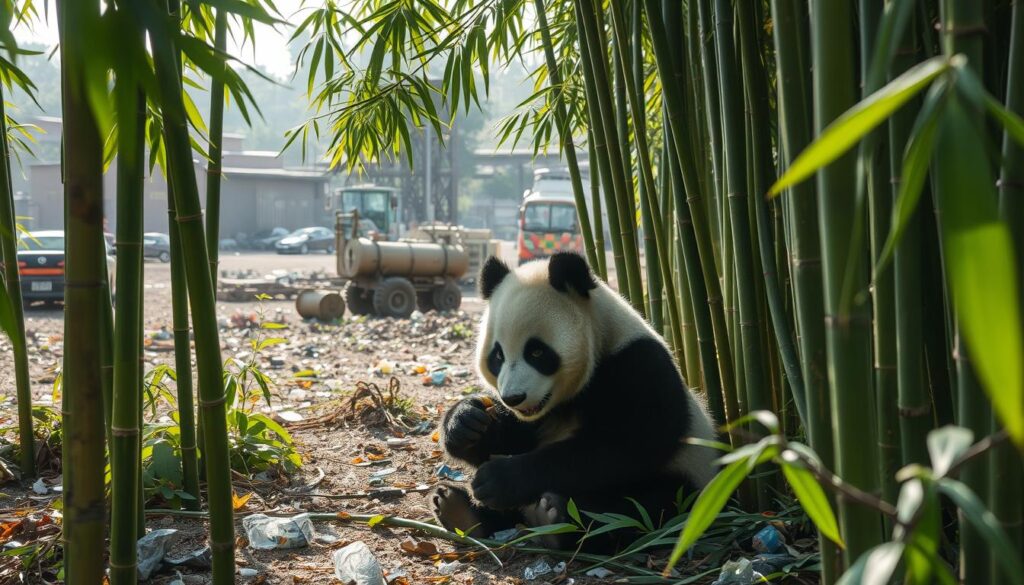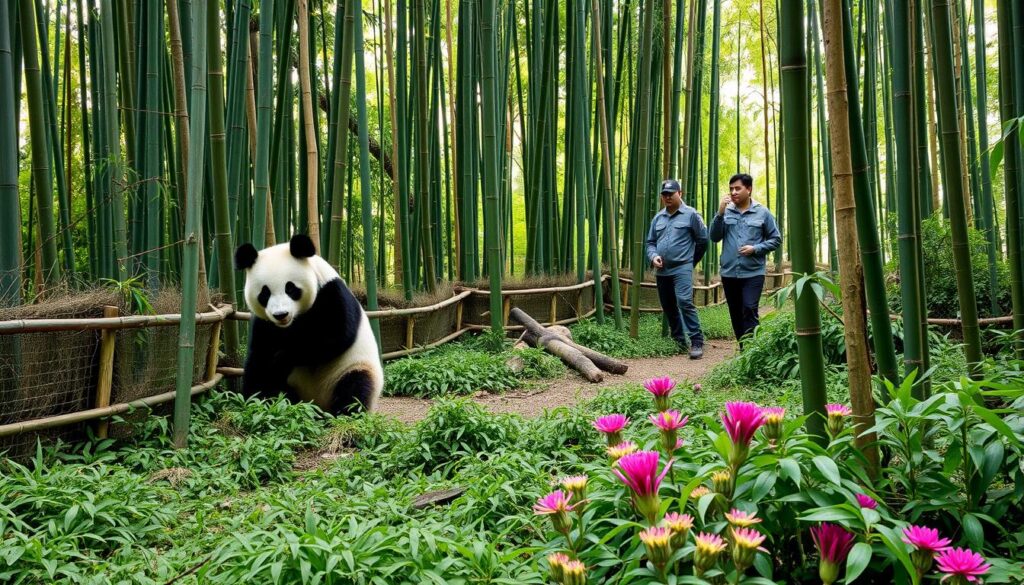The giant panda is a symbol of wildlife protection around the world. It plays Panda Conservation For Biodiversity a key role in keeping bamboo forests healthy. By saving the panda’s home, we also help other endangered animals like the golden snub-nosed monkey and the crested ibis.
Pandas are important to China’s economy, thanks to ecotourism. They are also a symbol of Chinese culture. The forests pandas live in are vital for local people, providing food, income, and fuel.
Pandas face big threats like habitat loss and climate change. Saving them is key to protecting the biodiversity of their habitats. By protecting pandas, we help the entire mountain forest ecosystem stay healthy.
Key Takeaways
- Giant pandas are a globally recognized conservation icon, playing a crucial role in maintaining the ecological balance of their bamboo forest habitats.
- Pandas are economically and culturally valuable to China, generating significant income through ecotourism and serving as the national symbol.
- Panda habitats are biodiversity hotspots, supporting a wide range of threatened and endangered species like the golden snub-nosed monkey and takin.
- Giant pandas face threats from habitat loss, fragmentation, and climate change, making conservation efforts essential for their survival and the preservation of the broader ecosystem.
- Protecting the giant panda ensures the health and resilience of the entire mountain forest ecosystem they inhabit.
The Giant Panda: A Conservation Icon
The giant panda is a beloved symbol of wildlife conservation. As WWF’s famous symbol, it has won hearts worldwide. Thanks to conservation, wild panda numbers are starting to rise.
Charismatic and Beloved Symbol of Wildlife Protection
Pandas are solitary animals that mostly eat bamboo, their main food. They have a special “thumb” to grip bamboo. This helps them spread seeds and grow vegetation.
Living Proof that Conservation Efforts Work
Now, there are 1,864 pandas in the wild, up from 1,000 in the late 1970s. This shows conservation is working. With 67 panda reserves and many wildlife corridors, the giant panda’s status has improved.
“The giant panda’s success story is living proof that conservation efforts can work, as wild panda numbers are starting to recover thanks to decades of successful protection measures.”
Even though the giant panda’s status has improved, there are only 1,864 left in the wild. Protecting their habitats and fighting threats like habitat loss and climate change is key to their survival.
Panda Conservation: Protecting More Than Just Pandas

Panda conservation is more than just saving the giant pandas. The bamboo forests they live in are full of other endangered animals. By saving the pandas’ home, we also protect the golden snub-nosed monkey, takin, and red panda.
Guardians of Bamboo Forests and Ecological Balance
Pandas are key to keeping bamboo forests healthy. They spread seeds and help plants grow. This way, pandas keep the forests thriving.
Safeguarding Habitats for Other Endangered Species
Protecting panda habitats also helps other endangered animals. These efforts not only save pandas but also protect many other species. This keeps the region’s biodiversity strong.
Conserving pandas shows the importance of protecting key species and their homes. As we save pandas, we also protect the bamboo forests and many other animals that depend on them.
| Key Panda Conservation Achievements | Impact |
|---|---|
| IUCN downlisted the giant panda from “endangered” to “vulnerable” in 2016 | Reflects the success of conservation efforts in increasing panda populations |
| Smithsonian scientists have trained over 1,500 Chinese wildlife professionals | Building local capacity for panda research and conservation |
| Smithsonian’s National Zoo contributed to multiple panda births through artificial insemination | Advancing understanding of panda reproduction to aid conservation |
| Smithsonian ecologists collaborate with China to expand and connect panda habitats | Ensuring the long-term survival of pandas by preserving and restoring their forests |
The success of panda conservation has a big impact. It helps not just the pandas but the whole ecosystem they live in. By protecting their habitat, we also save many other endangered species and keep the bamboo forests healthy.
The Economic and Cultural Value of Pandas

Giant pandas are very important to China. They are the national symbol, known for their black-and-white fur. Their image is everywhere in China, showing how much the country values them.
Generating Income through Ecotourism and Panda Conservation For Biodiversity
Pandas attract tourists, bringing in money for local areas. People enjoy watching pandas and buying panda-themed items. Studies say pandas and their homes are worth $2.6 to $6.9 billion a year.
Protecting pandas also helps other species. It’s more cost-effective than just keeping their homes safe.
China’s National Treasure and Symbol
The panda’s importance in China goes back a long way. They are seen as a national treasure. From 1990 to 2010, China worked hard to protect their homes.
Thanks to these efforts, pandas are no longer as endangered. China has created 67 panda reserves. This has helped keep pandas safe for the future.
| Panda Conservation Highlights | Value |
|---|---|
| Annual per-hectare value of panda reserves | $632 per hectare per year |
| Total value of ecosystem services from panda reserves (by 2010) | $2.6 to $6.9 billion per year |
| Value of protecting giant pandas as an “umbrella” species | 10 to 27 times more than the cost of maintaining reserves |
| Increase in panda habitat size (1990-2010) | Doubled |
| Number of panda reserves established by 2010 | 67, covering more than 33,000 km² |
The panda’s journey from endangered to vulnerable shows China’s dedication to conservation. As a symbol of China, protecting pandas has brought economic and cultural benefits. It highlights the need to keep this iconic species safe.
Understanding the Giant Panda’s Habitat

The giant pandas are loved for their role in wildlife conservation. They live in western China’s mountain ranges and forests. Mainly in Sichuan, Shaanxi, and Gansu provinces. Their homes are deciduous broadleaf, mixed conifer, and sub-alpine coniferous forests.
These forests are at elevations between 1,200 and 3,400 meters. The mountain ecosystems are crucial for the pandas. They provide the bamboo they need for food and shelter.
Mountain Ranges and Forests of Western China
The giant pandas live in western China’s mountainous regions. They thrive in the bamboo-filled forests. Their habitat is cool, humid, and rugged.
The Qionglai, Minshan, Qinling, and other ranges are their homes. However, human activities have made their habitat fragmented. This makes it hard for pandas to move and maintain genetic diversity.
Only about 1,864 giant pandas live in their natural habitat. Another 600 pandas are in zoos and breeding centers worldwide. The small panda populations face threats from habitat loss and genetic issues.
| Key Panda Habitat Facts | Statistics |
|---|---|
| Wild Giant Panda Population | Approximately 1,864 |
| Pandas in Zoos and Breeding Centers | Around 600 |
| Habitat Fragmentation | Severely fragmented due to human activities |
| Habitat Elevation | 1,200 to 3,400 meters |
| Habitat Vegetation | Deciduous broadleaf, mixed conifer, and sub-alpine coniferous forests |
The giant panda’s survival is linked to the health of western China’s mountain ecosystems. Saving these habitats is vital for the pandas and the region’s biodiversity.
Panda Conservation: Challenges and Threats

The giant panda faces big challenges and threats despite conservation efforts. Habitat loss and fragmentation are major issues. Human activities like deforestation and building projects have cut down bamboo forests. Climate change also threatens, as it could change where bamboo grows.
Habitat Loss and Fragmentation
Habitat loss makes pandas more vulnerable to predators and diseases. Isolated bamboo forests are too small for pandas. Hunting pandas is illegal in China, but poaching remains a threat.
Climate Change Impacts
Climate change could change where bamboo grows, affecting pandas’ food. Bamboo is 99% of a panda’s diet. Changes in bamboo could harm the species.
To overcome these threats, we need ongoing conservation efforts. Groups like the World Wildlife Fund and the China Wildlife Conservation Association are working hard. They focus on protecting habitats, stopping poaching, and breeding pandas in captivity.
“As the pandas’ habitat becomes more fragmented and degraded, they become increasingly vulnerable to natural predators and disease outbreaks.”
Conservation Efforts and Initiatives

Significant efforts are being made to protect the giant panda and its habitat. The Chinese government has set up over 2,500 nature reserves. Among these, 62 are for pandas. China aims to link these reserves into a large, protected area called the “Giant Panda National Park.”
The Nature Conservancy is working with China on a land trust model. This model lets private groups protect and manage lands and waters. It also helps local communities by starting eco-friendly guesthouses and agriculture programs. These activities help reduce the need for communities to depend on panda reserves.
China’s Panda Reserves and National Park Plans
The Chinese government has made big steps in panda conservation. They have set up over 2,500 nature reserves, with 62 for giant pandas. These reserves cover 54% of panda habitats and home to over 66% of the panda population. China plans to connect these reserves into a larger, protected area called the “Giant Panda National Park.”
The Nature Conservancy’s Land Trust Model
The Nature Conservancy is working with China on a land trust model. This model lets private groups protect and manage lands and waters. It offers livelihood solutions for local communities. This includes starting eco-friendly guesthouses and agriculture programs, reducing the need for communities to rely on panda reserves.
Sustainable Livelihood Programs for Local Communities
In China, conservation efforts also focus on local communities near panda habitats. They aim to reduce reliance on panda reserves by providing jobs. This includes eco-friendly guesthouses and sustainable agriculture. These programs empower local communities, protecting the giant panda and its mountain habitat for the future.
These efforts are crucial for the giant panda and its mountain habitat. They ensure a safe future for these animals.
Also Read : Virtual Tours of Panda Reserves: A Wildlife Adventure
Conclusion
The giant panda is a key conservation icon. It symbolizes our global efforts to save endangered species and protect biodiversity. Saving the pandas means protecting their unique mountain ecosystems too.
By keeping panda habitats safe, we also help other threatened species. This keeps the balance in these delicate places songer mcshea pandas may.
Pandas face big challenges like habitat loss, fragmentation, and climate change. But, thanks to the Chinese government and groups like The Nature Conservancy, there’s hope. Their work is crucial for the panda’s future.
By focusing on panda conservation, we protect China’s beloved national symbol. We also save the bamboo forests and habitats of many endangered species.
The success of giant panda conservation shows us the power of commitment. With the right conservation programs, we can help global biodiversity. This ensures the survival of iconic species like the giant panda.
FAQs
Q: Why is panda conservation important for biodiversity?
A: Panda conservation is crucial for biodiversity because giant pandas play a significant role in their ecosystem. As a keystone species, their presence helps maintain the health of the bamboo forests they inhabit, which in turn supports numerous other species. Protecting pandas and their habitat contributes to overall ecological stability and biodiversity.
Q: How does the WWF contribute to panda conservation?
A: The WWF (World Wildlife Fund) actively works towards panda conservation by funding research, supporting giant panda habitat preservation, and establishing giant panda reserves in Sichuan Province, China. Their efforts aim to prevent extinction and promote the survival of giant pandas in the wild.
Q: What are the main threats to giant pandas and their habitat?
A: The main threats to giant pandas and their habitat include habitat loss due to deforestation and human encroachment, impacts of climate change on giant panda habitat, and diseases such as canine distemper. These factors contribute to the declining population of wild pandas and threaten their survival.
Q: Where do giant pandas live?
A: Giant pandas primarily live in the mountainous regions of southwest China, specifically in Sichuan Province. Their habitat consists of bamboo forests, which are essential for their diet and survival.
Q: What role do zoos play in panda conservation?
A: Zoos, especially those affiliated with conservation biology institutes, play a vital role in panda conservation by participating in breeding programs, educating the public about pandas and their habitat, and supporting global conservation efforts. The National Zoo, for example, collaborates with organizations like the WWF to promote awareness and conservation initiatives.
Q: How does climate change affect giant pandas?
A: Climate change threatens giant pandas by altering their habitat and the availability of bamboo, their primary food source. Changes in temperature and precipitation patterns can impact bamboo growth, thus affecting the survival of giant pandas in their natural environment.
Q: What is the significance of giant panda reserves?
A: Giant panda reserves are designated areas that provide a protected environment for giant pandas and their habitat. These reserves are essential for conservation efforts as they help sustain wild panda populations, facilitate research, and promote biodiversity by preserving the ecological integrity of the area.
Q: How do giant panda breeding programs help conservation efforts?
A: Giant panda breeding programs are crucial for increasing the population of giant pandas in captivity and enhancing genetic diversity. Successful breeding initiatives can lead to the release of giant panda cubs into the wild, contributing to the recovery of the wild panda population and supporting the species’ long-term survival.
Q: What is the future outlook for giant pandas?
A: The future of giant pandas is cautiously optimistic due to ongoing conservation efforts. While they remain classified as vulnerable, initiatives by organizations like the WWF, government policies for habitat protection, and public awareness campaigns are helping to stabilize and potentially increase wild panda populations.
Q: How can individuals help in panda conservation?
A: Individuals can contribute to panda conservation by supporting organizations like the WWF, participating in awareness campaigns, making sustainable choices that reduce environmental impact, and visiting accredited zoos that prioritize conservation biology. Engaging in these efforts helps promote the protection of giant pandas and their habitat.

